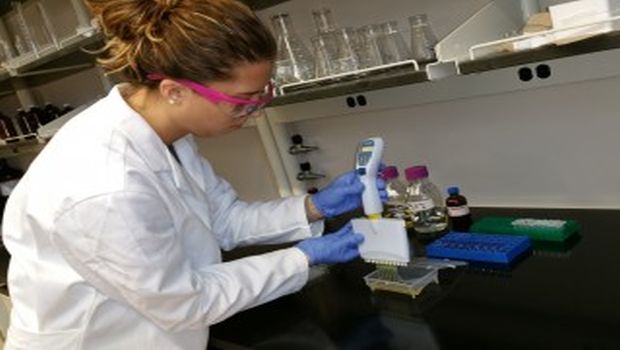 Graduate student Nicole Kennedy measures the antibiotic activity of various samples in the lab. Photo courtesy of Olya Keen Graduate student Nicole Kennedy measures the antibiotic activity of various samples in the lab. Photo courtesy of Olya Keen Chlorine, a disinfectant commonly used in most wastewater treatment plants, may be failing to completely eliminate pharmaceuticals from wastes. As a result, trace levels of these substances get discharged from the plants to the nation’s waterways. And now, scientists are reporting preliminary studies that show chlorine treatment may encourage the formation of new, unknown antibiotics that could also enter the environment, potentially contributing to the growing problem of antibiotic resistance. The research, which will be presented March 23 at the 249th National Meeting & Exposition of the American Chemical Society (ACS), suggests that a re-evaluation of wastewater treatment and disinfection practices is needed. “Pharmaceuticals that get out into the environment can harm aquatic life, making them react slowly in the wild and disrupting their hormone systems,” notes Olya Keen, PhD. She adds that increased antibiotic exposure, even at low levels in the environment, can lead to development of antibiotic-resistant microbes and a general weakening of antibiotics’ abilities to fight bacterial infections in humans. “Treated wastewater is one of the major sources of pharmaceuticals and antibiotics in the environment,” says Keen. “Wastewater treatment facilities were not designed to remove these drugs. The molecules are typically very stable and do not easily get biodegraded. Instead, most just pass through the treatment facility and into the aquatic environment.” But besides failing to remove all drugs from wastewater, sewage treatment facilities using chlorine may have the unintended consequences of encouraging the formation of other antibiotics in the discharged water. Keen, graduate student Nicole Kennedy and others in her team at the University of North Carolina at Charlotte ran several lab experiments and found that exposing doxycycline, a common antibiotic, to chlorine in wastewater increased the antibiotic properties of their samples. “Surprisingly, we found that the products formed in the lab sample were even stronger antibiotics than doxycycline, the parent and starting compound,” she adds. Keen has not yet identified all the properties of these “transformation products,” and that research is now underway. She notes that these compounds could turn out to be previously unidentified antibiotics. Keen explains that the best solution may be to decrease the amount of these drugs that reach a treatment plant in the first place. Currently, disposal of pharmaceuticals is not regulated, however. So she urges a greater emphasis on collecting and incinerating old pharmaceuticals, rather than dumping them down the drain or placing them in the trash, which can lead to harmful environmental exposures. In addition, this research has applications to drinking water treatment systems, most of which also use chlorine as a disinfectant, she says. To purify drinking water, chlorine must remain in the distribution piping system for hours, which blocks microbes from growing. But this also provides ample time for chlorine to interact with pharmaceuticals that may be in the water, encouraging development of new antibiotic compounds. Keen acknowledges funding from the University of North Carolina at Charlotte and the National Science Foundation. Source: American Chemical Society |
AuthorWritten by http://www.infectioncontroltoday.com Archives
December 2016
|

 RSS Feed
RSS Feed
